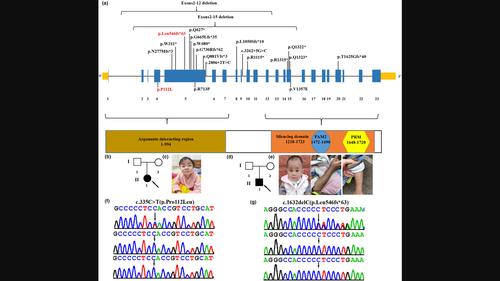当前位置:
X-MOL 学术
›
Mol. Genet. Genomic Med.
›
论文详情
Our official English website, www.x-mol.net, welcomes your feedback! (Note: you will need to create a separate account there.)
Novel variants in TNRC6B cause global developmental delay with speech and behavioral abnormalities, short stature, low body weight, café‐au‐lait spots, and metabolic abnormality
Molecular Genetics & Genomic Medicine ( IF 2 ) Pub Date : 2024-02-26 , DOI: 10.1002/mgg3.2408 Qi Yang 1, 2 , Shan Ou 1, 2 , Xunzhao Zhou 1, 2 , Sheng Yi 1, 2 , Li Lin 1, 2 , Shang Yi 1, 2 , Shujie Zhang 1, 2 , Zailong Qin 1, 2 , Jingsi Luo 1, 2, 3
Molecular Genetics & Genomic Medicine ( IF 2 ) Pub Date : 2024-02-26 , DOI: 10.1002/mgg3.2408 Qi Yang 1, 2 , Shan Ou 1, 2 , Xunzhao Zhou 1, 2 , Sheng Yi 1, 2 , Li Lin 1, 2 , Shang Yi 1, 2 , Shujie Zhang 1, 2 , Zailong Qin 1, 2 , Jingsi Luo 1, 2, 3
Affiliation

|
BackgroundTNRC6B deficiency syndrome, also known as global developmental delay with speech and behavioral abnormalities (MIM 619243), is a rare autosomal dominant genetic disease mainly characterized by facial dysmorphism, developmental delay/intellectual disability (DD/ID), speech and language delay, fine and motor delay, attention deficit and hyperactivity disorder (ADHD), and variable behavioral abnormalities. It is caused by heterozygous variant in the TNRC6B gene (NM_001162501.2, MIM 610740), which encodes the trinucleotide repeat‐containing adaptor 6B protein.MethodsIn this study, two Chinese patients with TNRC6B deficiency syndrome were recruited, and genomic DNA extraction from peripheral blood leukocytes of these parents and their family members was extracted for whole‐exome sequencing and Sanger sequencing.ResultsHere, we report two unrelated Chinese patients diagnosed with TNRC6B deficiency syndrome caused by novel de novo likely pathogenic or pathogenic TNRC6B variants c.335C>T (p.Pro112Leu) and c.1632delC (p.Leu546fs*63), which expands the genetic spectrum of TNRC6B deficiency syndrome. The clinical features of the patients were DD/ID, delayed speech, ADHD, behavioral abnormalities, short stature, low body weight, café‐au‐lait spots, metabolic abnormalities, and facial dysmorphism including coarse facial features, sparse hair, frontal bossing, hypertelorism, amblyopia, strabismus, and downslanted palpebral fissures, which expands the phenotype spectrum associated with TNRC6B deficiency syndrome.ConclusionThis study expands the genotypic and phenotypic spectrum of TNRC6B deficiency syndrome. Our findings indicate that patients with TNRC6B deficiency syndrome should be monitored for growth and metabolic problems and therapeutic strategies should be developed to address these problems. Our report also suggests the clinical diversity of TNRC6B deficiency syndrome.
更新日期:2024-02-26



























 京公网安备 11010802027423号
京公网安备 11010802027423号